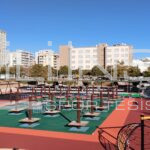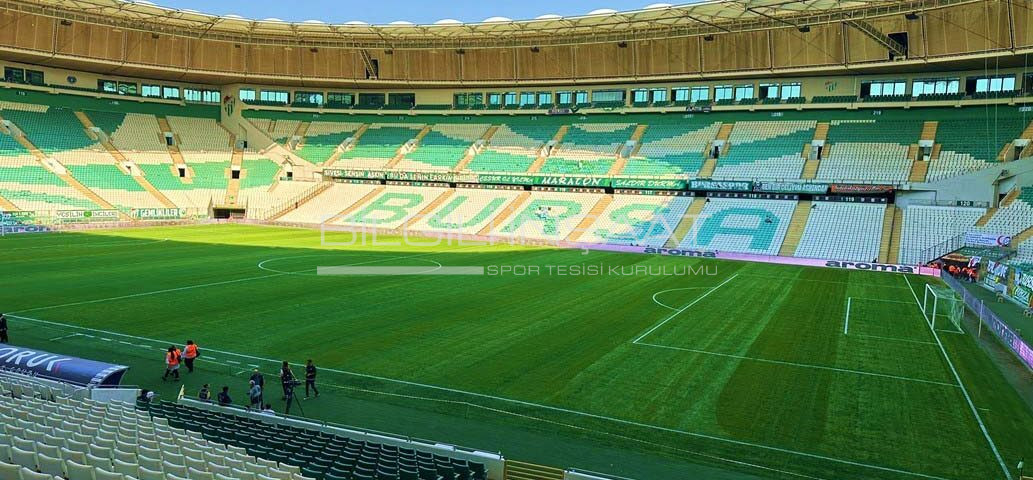
Yozgat FIFA Approved Synthetic Turf, Runway Maintenance and Repair Project
27 November 2024
Adana/ Cumhuriyet Parkı ve Spor Parkı Zemin Kaplama Yapım İşi
16 March 2025Hybrid grass, a powerful combination of natural and artificial turf, is solidifying its place in the future of sports fields. Thanks to its enhanced durability, these surfaces can be used for extended periods and offer four times more usage capacity than natural grass alone. This improves game quality and reduces maintenance requirements. So, how is a professional hybrid grass field constructed? This guide will delve into every stage in detail, from selecting the right materials to installing hybrid turf and maintenance tips for longevity. Additionally, we aim to inspire with successfully completed hybrid grass field projects and examples. If you’re a construction professional looking to make a difference in your projects, this guide is perfect for you!
You can review the projects we have done and get technical information on our Hybrid Grass page.

If you want professional hybrid grass application, please contact us immediately.
Başlıklar
- 1 Advantages of Hybrid Grass Fields
- 2 Material Selection and Preparation Process
- 3 Ground Preparation and Drainage Systems
- 4 Hybrid Grass Installation: Step-by-Step Guide
- 5 Maintenance Tips for Longevity
- 6 Performance and Game Quality of Hybrid Grass Fields
- 7 Hybrid Grass Field Projects and Examples
- 8 Frequently Asked Questions (FAQs)
Advantages of Hybrid Grass Fields
Hybrid grass fields, combining natural and synthetic materials, offer numerous advantages. These fields provide significant benefits for both professional athletes and field management. Before understanding how to construct a hybrid grass field (Professional), let’s look at some key advantages:
Increased Durability and Usage Time: Hybrid grass fields offer four times the football-playing capacity of natural grass fields. This allows for more events and football matches, leading to increased revenue.
Improved Game Quality: The soft texture of natural grass and the durability of artificial turf combine to create a more consistent surface. This enhances ball rolling speed and game control.
Reduced Maintenance Costs: Hybrid turf surfaces significantly reduce maintenance needs and costs. Synthetic components, in particular, require less watering and fertilization, saving water and maintenance resources.
Better Drainage Capacity: These fields feature advanced drainage systems that minimize water retention after heavy rains. This ensures faster drying after games and allows for more frequent use.
Longevity and Eco-Friendliness: Hybrid grass is an eco-friendly alternative thanks to the intelligent use of biodegradable materials. These fields have a long lifespan, reducing their environmental footprint.
Below is a summary table of these advantages:
| Advantage | Details |
|---|---|
| Increased Durability | 4x more usage capacity, increased event count |
| Improved Quality | Enhanced ball control and game comfort |
| Reduced Maintenance | Less need for water and maintenance products |
| Drainage Capacity | Advanced drainage, faster drying time |
| Longevity | Eco-friendly and long-lasting use |
As a result, Hybrid Grass offers both cost-effective solutions and features that improve the quality of play and maintenance. These advantages facilitate the wider use of hybrid turf technology in sports facility management.
Material Selection and Preparation Process
To answer the question, “How to Construct a Hybrid Grass Field? (Professional),” the process begins with selecting the right materials. The quality of materials is critical to the success of hybrid turf applications. Therefore, materials should be chosen according to the soil structure and usage requirements.
Material Selection
Natural Grass Seed: Select durable types of natural grass seeds suitable for the climate. A mixture of frequently used types provides both aesthetic and functional advantages.
Synthetic Fiber: Opt for high-quality synthetic fibers that enhance durability, resist UV rays, and provide a soft texture. These materials are woven in harmony with natural grass to strengthen the field surface
Base Materials: The subbase must be supported with materials of different granule sizes to bear the load and maintain the smooth structure of the surface.
Preparation Process
After selecting the right materials, a systematic approach should be taken in preparing the hybrid grass field:
Ground Examination: Before installation, conduct an analysis of soil suitability, including drainage and permeability factors.
Cleaning and Leveling: Remove foreign materials from the surface and level uneven areas. This ensures both aesthetic and functional success.
Drainage Adjustments: Install an effective drainage system to prevent water accumulation and test the system’s functionality.
The following table explains the critical points of material selection and preparation:
| Step | Description |
|---|---|
| Natural Grass Seed | Use durable types suited to the climate |
| Synthetic Fiber | Choose UV-resistant, durable, compatible fibers |
| Ground Examination | Analyze drainage and soil permeability |
| Cleaning & Leveling | Remove foreign materials, level the surface |
| Drainage Adjustments | Install a system to prevent water pooling |
These processes form the foundation for the durability and performance of hybrid grass field projects. Paying attention to these steps ensures a more efficient installation and field usage in the long term.
Ground Preparation and Drainage Systems
One of the most critical steps in answering “How to Construct a Hybrid Grass Field? (Professional)” is ground preparation and drainage system installation. This step is vital for ensuring the longevity and optimal performance of the hybrid grass field. Insufficient ground preparation or ineffective drainage systems can lead to serious issues, such as water pooling, surface deformation, and even root rot. Therefore, construction professionals must apply proper ground preparation and effective drainage solutions.
Ground Preparation Steps:
Site Analysis: Begin by measuring the area and conducting soil tests to understand the ground composition. This helps determine how to structure the drainage systems.
Soil Grading: Smooth out all bumps and depressions on the surface to achieve a uniform base. Proper leveling ensures even water distribution and promotes healthy root growth.
Subbase Layer Installation: Create a sturdy subbase layer that allows for proper root anchoring and a stable field surface. This layer must be firm yet permeable.
Drainage Systems:
Surface Drainage: Use appropriate slopes and water channels to quickly remove surface water. Open channels or sloped drainage grooves can be effective.
Underground Drainage: In regions with heavy rainfall, underground drainage systems may be required. Pipes and drainage covers are used to rapidly remove excess water from beneath the field.
Drainage Materials: Use high-quality, durable drainage materials like PVC pipes, gravel, and sand layers to ensure the system’s longevity and functionality.
By meticulously planning and implementing ground preparation and drainage systems, you can extend the lifespan of hybrid grass fields. A well-structured ground and drainage system not only increases durability but also provides a safe and high-performance surface for players. Careful work and professional equipment usage during this stage play a decisive role in the success of the project.
Hybrid Grass Installation: Step-by-Step Guide
To effectively address “How to Construct a Hybrid Grass Field? (Professional),” it’s crucial to break the process into clear, actionable steps. Here is a detailed step-by-step guide for hybrid grass installation:
1. Infrastructure and Drainage Preparation:
- Soil Analysis: Begin by analyzing the existing soil to plan appropriate drainage systems.
- Drainage System Installation: Install drainage channels and pipes to prevent water retention and ensure quick drying after rain.
2. Laying the Subbase Layers:
- Geotextile Fabric: Lay geotextile fabric over the drainage system to prevent soil erosion.
- Granite Dust and Sand Layers: Apply a mixture of granite dust and sand to enhance durability and create a smooth surface.
3. Installing Hybrid Grass:
- Synthetic Turf Layer: Lay synthetic turf sheets according to field dimensions, ensuring edges fit snugly.
- Natural Grass Seeding: Carefully seed natural grass between synthetic fibers to blend the two surfaces seamlessly.
4. Securing and Joining:
- Stitching and Adhesives: Use specialized stitching tools and adhesives to secure synthetic turf sheets. This step enhances the field’s longevity and stability.
5. Initial Maintenance and Testing:
- Root Establishment: Water the field regularly to ensure natural grass roots integrate with the soil and synthetic fibers.
- Performance Testing: Conduct tests to evaluate ball behavior, player traction, and overall surface performance.
The table below provides a brief overview of the materials required and points to consider at each step:
| Step | Required Materials | Key Considerations |
|---|---|---|
| Drainage Preparation | Soil analysis tools, drainage pipes | Proper slope and functional drainage channels |
| Subbase Installation | Geotextile fabric, granite dust, sand | Uniform distribution and compacting |
| Grass Installation | Synthetic turf, natural grass seeds | Seamless blending of edges and proper seeding |
| Securing and Joining | Stitching tools, adhesives | Strong, durable connections |
| Initial Maintenance | Irrigation system, grass care tools | Regular watering and growth monitoring |
A hybrid grass field constructed following these steps ensures long-term performance and player safety. The proper blending of materials and adherence to professional standards create a high-quality playing surface that meets the demands of modern sports.
Maintenance Tips for Longevity
After constructing a hybrid grass field, regular maintenance is essential to ensure its longevity and high-quality performance. Hybrid grass fields not only need to look perfect but also remain healthy and durable. Here are some important maintenance tips to help keep your hybrid grass field at its best:
Routine Mowing and Cleaning:
- Mowing Frequency: Hybrid grass should be mowed regularly, just like natural grass. Proper mowing supports root strengthening and maintains field consistency.
- leaning: Remove debris, leaves, and other waste that could block sunlight and hinder healthy growth.
Irrigation and Drainage Management:
- Irrigation Timing: Water the field early in the morning or late in the evening to minimize evaporation. Adjust water needs based on seasonal and climatic conditions.
- Drainage System Checks: Regularly inspect drainage systems to ensure they are free of blockages and functioning properly.
Nutrition and Soil Management:
- Fertilization: Implement a balanced fertilization program to ensure the grass receives essential nutrients. This is especially important after intensive usage.
- Aeration: Aerate the soil to improve oxygen penetration and prevent compaction, contributing to a more flexible and durable field.
Damage Repair and Protection:
- Damage Assessment: Regularly inspect the field for any damage caused during games or events. Prompt repairs prevent further deterioration.
- Protection Measures: Use protective coverings during high-intensity events to prevent excessive wear and tear.
With these methods, which answer the question “How to Build a Hybrid Grass Field? (Professional),” you can enhance the durability of your hybrid grass fields and create long-lasting areas that maintain their health and game quality for years. Through careful and regular maintenance, you can ensure an optimal gaming experience for both players and spectators.
Performance and Game Quality of Hybrid Grass Fields
Hybrid grass fields, offering a unique combination of natural grass and artificial turf, significantly enhance field performance. Why should this type of turf be preferred, what advantages does it offer, and how does it affect game quality? Here are the details:
Performance and Durability
Higher Utilization Capacity: Hybrid grass fields provide four times the playing capacity compared to natural grass fields. This allows for an increased number of events and football matches, offering a major advantage for football clubs with tight schedules.
Faster Recovery Process: Hybrid grass technology supports faster regeneration of natural grass. Damage on the field is minimized, and the field returns to its previous state more quickly.
Traction and Stability: The added durability of the hybrid structure provides players with better grip on the field. This reduces the risk of injury during sudden movements and enhances player performance.
Game Quality
Ball Control and Speed: One of the most remarkable features of the Performance and Game Quality of Hybrid Grass Fields is the interaction between the ball and the surface. Hybrid strips allow the ball to bounce more consistently, maximizing player control.
Slipperiness and Surface Structure: The slipperiness issue commonly encountered in traditional natural grass fields is greatly reduced in hybrid grass. This improves game quality and enhances player safety during matches.
Comparison Table
| Feature | Natural Grass Fields | Hybrid Grass Fields |
|---|---|---|
| High Utilization | Moderate | High |
| Maintenance Needs | High | Moderate |
| Recovery Time | Long | Short |
| Traction | Variable | Consistent |
| Ball Control | Moderate | High |
| Slipperiness | High | Low |
Conclusion
The construction techniques of Hybrid Grass Fields are a correct choice to enhance field performance and ensure player safety. These fields provide a better gaming experience for increasingly popular matches while reducing maintenance costs in the long term. With their high utilization capacity and player safety-supporting structure, hybrid grass fields are an intelligent choice for modern sports complexes.
Hybrid Grass Field Projects and Examples
As detailed in the topic “How to Construct a Hybrid Grass Field? (Professional),” the adoption of hybrid grass technology has grown globally. This shift is driven by its ability to accommodate more game time, resist wear and tear, and require less maintenance. Below are notable hybrid grass field projects and examples that showcase the success of this innovative technology
Prominent Hybrid Grass Field Projects
Wembley Stadium, England: Wembley Stadium is one of the most iconic venues to adopt hybrid grass technology. Hosting high-capacity football matches, concerts, and events, the field requires exceptional durability. Hybrid grass offers a perfect blend of natural and synthetic materials, providing the strength needed for these demands.
Allianz Arena, Germany: The Allianz Arena in Munich adopted hybrid grass to ensure playability in all weather conditions. Even with prolonged use, the field maintains its durability and consistent performance, becoming a benchmark for hybrid grass fields.
Steps in Implementing a Hybrid Grass Field Project
Below is a summary of the critical steps involved in implementing a hybrid grass field project:
| Step | Description |
|---|---|
| 1. Analysis | Evaluate the current state and field requirements. |
| 2. Planning | Develop a detailed plan tailored to the project’s needs. |
| 3. Ground Preparation | Level the surface and install drainage systems. |
| 4. Hybrid Grass Installation | Lay synthetic turf and seed natural grass. |
| 5. Testing & Maintenance | Ensure the field meets performance and safety standards. |
Use Cases for Hybrid Grass Fields
- Football Stadiums: Hybrid grass is ideal for football stadiums with busy schedules. Its durability and ability to handle heavy foot traffic make it a favorite among professional teams.
- Multi-Purpose Sports Fields: Beyond football, hybrid grass can be adapted for rugby, American football, and other sports, offering versatility for various games.
- Event Venues: Hybrid grass fields can withstand wear from concerts, festivals, and other events, making them highly practical for multi-use venues.
The success of these projects requires the use of the right materials and careful work during the application process. Hybrid grass field projects are frequently mentioned in both local and international arenas by offering solutions suitable for the needs of modern sports facilities.
Frequently Asked Questions (FAQs)
What is a hybrid grass field?
A hybrid grass field combines natural grass and synthetic turf to create a durable, low-maintenance, and high-performance surface.
What materials are used in hybrid grass field construction?
Materials typically include natural grass seeds, synthetic turf fibers, sand, gravel, and special adhesives.
How long does it take to construct a hybrid grass field?
Depending on the project size and site conditions, the construction period can range from a few weeks to a few months.
How is a hybrid grass field maintained?
Maintenance involves regular mowing, cleaning, irrigation, and occasional aeration to maintain the balance between natural and synthetic components.


